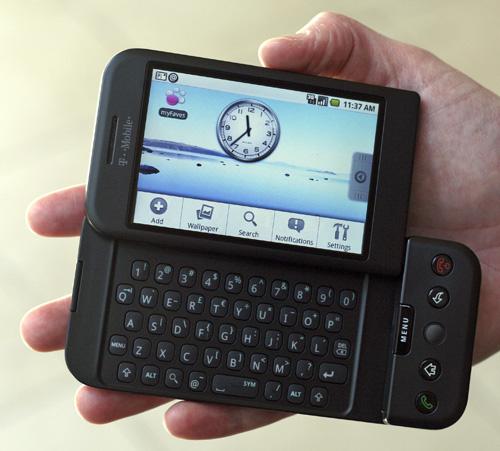Google extends Internet presence in new cell phone

The T-Mobile G1 Android-powered phone, the first cell phone with the operating system designed by Google Inc., is shown on Tuesday in New York. Mark Lennihan, The Associated Press
Sep 24, 2008
Last updated on May 13, 2016 at 02:24 p.m.
NEW YORK – The first phone that harnesses Google Inc.’s ambition to make the Internet easy to use on the go was revealed Tuesday, and it looks a lot like an iPhone.
T-Mobile USA showed off the G1, a phone that, like Apple Inc.’s iPhone, has a large touch screen. But it also packs a trackball, a slide-out keyboard and easy access to Google’s e-mail and mapping programs.
T-Mobile said it will begin selling the G1 for $179 with a two-year contract. The device hits U.S. stores Oct. 22 and heads to Britain in November and other European countries early next year.
The phone will be sold in T-Mobile stores only in the U.S. cities where the company has rolled out its faster, third-generation wireless data network. By launch, that will be 21 cities, including New York, Los Angeles, Houston and Miami.
Get The Daily Illini in your inbox!
In other areas, people will be able to buy the phone from T-Mobile’s Web site. The phone does work on T-Mobile’s slower data network, but it’s optimized for the faster networks. It can also connect at Wi-Fi hotspots.
The data plan for the phone will cost $25 per month on top of the calling service, at the low end of the range for data plans at U.S. wireless carriers. And at $179, the G1 is $20 less than the least expensive iPhone in the U.S.
Android, the free software powering the G1, is a crucial building block in Google’s efforts to make its search engine and other services as accessible on cell phones as they already are on personal computers. The company believes it eventually might make more money selling ads that get shown on mobile devices than on PCs, a channel that will generate about $20 billion in revenue this year.
Both Yahoo Inc. and Microsoft Corp. also are investing heavily in the mobile market in hopes of preventing Google from extending the dominance it enjoys in searches initiated on PCs.
In an interview, Google co-founder Sergey Brin said Google’s aims are broader than mobile advertising.
“Generally, we think if there are great (operating systems) out there that let people have great devices and great applications, people use the Internet on their phones much more,” Brin said at the launch event in New York. “And whenever people use the Internet more, they end up using our services, and ultimately, that’s good for our business. There’s no secret plan to have ads pop up or anything.”
Like the iPhone, the G1 has a high-resolution screen, making it easier to browse Web sites that haven’t been specifically adapted for a cell phone. However, unlike the iPhone, Research in Motion Ltd.’s BlackBerry models and most other high-end smart phones sold in the U.S., the G1 has a very limited ability to connect to corporate e-mail servers, which means the device’s initial market is likely to be consumers.





